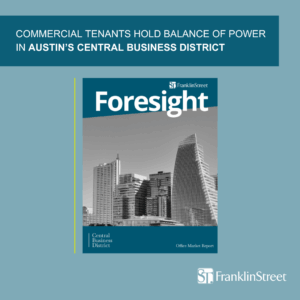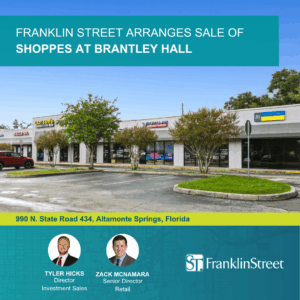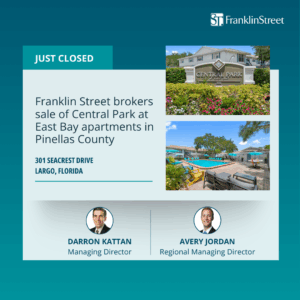The New Year is set to begin on a positive note for North Florida, as job growth, new development and retailer expansion show no signs of slowing across the Sunshine State.
At the close of the third quarter, total vacancy stood at 7.3 percent in the North Florida markets of Jacksonville, Orlando and Tampa — a year-over-year decline of 70-basis-points, according to the Q3 Florida Retail MarketView report by CBRE.
Heavy pre-leasing in centers scheduled for delivery in the fourth quarter is expected to push 2015 net absorption ahead of the 2014 total, despite the fact that the average pace of net absorption for the frst three quarters of the year was nearly 100,000 square feet less than the quarterly average in 2014, according to CBRE’s report.
Rents in the market continue to increase, with a third quarter rate of $14.45 per-square foot in North Florida, a 1.7 percent year-over-year increase according to CBRE’s MarketView.
“I think rents will always be a direct result of supply and demand,” says Whitney Kantor, director of retail leasing in Franklin Street’s Jacksonville offce. “Retailers want ‘A’ locations, and they want the best sites, so your higher quality projects are defnitely going to continue to demand higher rents.”
The grocery market remains active across Florida, with organic and specialty grocers continuing to open throughout the state. Grocery sales throughout Florida are being driven by delivery and curbside pick-up services, notes CBRE.
As for development, Florida saw retailer deliveries totaling nearly 1 million square feet in the third quarter, with over 4.2 million square feet under construction and 1.5 million square feet expected to deliver by years end.
The use of smaller footprints and “tryon” stores continues to be a trend in the market, allowing increased productivity per-square-foot and enhanced customer service. Place making continues to be important for retail development with the implementation of entertainment and outdoor elements, as well as large public amenities aimed at generating foot traffc, according to CBRE’s MarketView.
The conversion of vacant buildings with smaller footprints, like gas stations, will be a big play for restaurants as retailers maintained a continued interest in nontraditional shopping centers, notes Kantor. “The desire for nontraditional by retailers and consumers will continue to fuel redevelopment of existing traditional shopping centers.”
“At Regency, we’re focusing on building visually appealing, customer-friendly shopping centers with common seating, fire features and rooftop decks,” says Patrick McKinley, senior leasing agent at Regency Centers. “That’s the goal with our new development, and in our existing shopping centers where it makes sense.”
Job growth continues to be seen throughout the state, with large technology companies and health care facilities moving into Gainesville. This growth, alongside robust performances in the housing and tourism markets, is expected to fuel retailer interest and development in the northern parts of the state.
JACKSONVILLE
Vacancy rates in Jacksonville have continued to decline, dipping to 9.2 percent, the lowest level since third quarter 2008 according to CBRE’s Q3 Jacksonville MarketView.
Moving into the fourth quarter, Jacksonville has seen 315,806 square feet of net absorption, with the most positive activity occurring in the Westside and Regency submarkets.
“Downtown Jacksonville will continue to be something to watch,” says Kantor. “The areas of Brooklyn Riverside will continue to be sought out, as well as San Marco. The beaches will also continue to be strong.”
Notable developments in Jacksonville include Brooklyn Station on Riverside and the continuing development of St. Johns Town Center. The leading retail destination in the market, St. Johns Town Centers sits on an over 60-acre site comprised of 200,000 square feet of retail space, 150 hotel rooms and 350 apartment units.
“If you’ve been to Jacksonville, you’ve heard of St. Johns Town Center,” says McKinley. “It’s really the epicenter of Jacksonville retail. There are several projects underway on land periphery to the center.”
Regency is nearing completion at Brooklyn Station on Riverside. “Brooklyn Station is a Fresh Market-anchored, 40,000-square-foot shopping center,” says McKinley. “We have 30,000 square feet of small shop space that is mostly street front and the restaurants have ample outdoor patio areas.”
In order to cater to the largely millennial and empty nester population in northern Florida, Regency has implemented strong place making throughout Brooklyn Station. “One of the tenants opening in the frst part of this year, Burrito Gallery, has a rooftop deck with a great skyline view of downtown Jacksonville. We’ve also incorporated lots of unique materials and bright, vibrant colors in the shopping center.”
Regency also hired artists to paint murals on the walls of the shopping center to help set the development apart from other retail destinations in the area. “We had two different muralists paint murals on the shopping center,” says McKinley. “One of the muralists actually painted photos from our site in the early 1900s to pay homage to what the neighborhood was, and depict what the shopping center site once looked like.”
Retailers expanding into Jacksonville include IKEA, which plans to break ground on the company’s ffth Florida location at St. Johns Town Center next year, and Top Golf, which recently closed on a 15-acre parcel in the area, according to CBRE’s Jacksonville MarketView.
“In Jacksonville, the most active categories I’ve seen expanding right now are organic grocers, quick-service restaurants, craft beer bars, ftness concepts, pet care, massage tenants, residential real estate offces, coffee shops and quick cut hair,” says McKinley.
“The growth in Jacksonville is very similar to the growth path that Charlotte took,” says Kantor. “It will be exciting to watch as the projects and redevelopments that have been talked about for a long time begin to take further shape and come to fruition.”
GAINESVILLE
Retail development continues to escalate in historically under-retailed Gainesville, from the Butler Plaza expansion to Celebration Pointe. “Gainesville is just exploding right now,” says Kantor. “We’re seeing an expansion of U.S. Health, and a growing innovation hub — all of this will continue to spur retail development.”
At current, Butler Enterprises is set to double the size of its popular Butler Plaza with the addition of Butler North, currently underway, and the upcoming Butler Town Center. These additions will bring the project to nearly 2 million square feet.
Butler North comprises 754,000 square feet, and is 77 percent leased with another 17 percent in negotiation at current.
The center plans for a rolling opening with the 111,000-square-foot Lowe’s opening in January; a 140,000-squarefoot Sam’s Club opening in July; a 192,000-square-foot Walmart Supercenter opening in August; and Dick’s Sporting Goods opening in the fall. The majority of retailers are set to open by the end of 2016.
Construction on Butler Town Center is set to begin during 2016, and will bring an additional 350,000 square feet of retail space.
“While there have been many milestones during the 75 years of Butler Enterprises’ history, nothing makes me more proud than the opening of Butler North and the ground breaking of Butler Town Center,” says Deborah Butler, president
of Butler Enterprises.
“The synergy of coupling these two new developments with Butler Plaza completes not only the development of our 267 acre parcel, but also enables our retailers to provide a complete shopping experience to the 1.2 million people within the boundaries of our 15 county regional market,” she continues.
“The growth that is happening for retail in the Gainesville market is very appropriate with the general growth in the city, the changing lifestyles of people and with the changing face of retail in general today,” says Rebecca Maccardini, consultant at RMResources LLC, who is working with Butler Enterprises.
Celebration Pointe, a $200 million mixed-use development located at the intersection of Interstate 75 and Archer Road, is also underway in Gainesville. The development will be comprised of 350,000 square feet of open-air retail in the form of a Main Street, 300,000 square feet of Class A offce space, a 137-room Hotel Indigo and 1,000 apartment units.
“Our Main Street component, from Bass Pro Shops to Regal Cinemas, will not be vehicular,” says Ralph Conti, principal and managing member of RaCo Real Estate. “We’re making this project 100 percent pedestrian. What Gainesville is missing is a place that people can go. Gainesville has a very fragmented downtown area with no real continuity — you have the University of Florida, student housing and bits and pieces of small retail. What you don’t have is a place where the customer can work, live and play.”
“Moving off of the main street, you enter what we call technology park. We’re in the process of closing our deal with software company InfoTech, which is set to build a 60,000-square-foot headquarters.”
“We are continuing to put public infrastructure in place, and we’re on schedule,” continues Conti. “In the frst quarter of 2016, you’ll be seeing vertical construction— Our Bass Pro Shops anchor, the InfoTech offce building, the Hotel Indigo and a second 80,000-square-foot offce building will be underway.”
“Gainesville is a growing market, and to me, it’s the best kept secret in Florida,” says Conti. “About 40 percent of Gainesville’s population is comprised of millennials, and they are driving retail right now. Not only do they want to have some level of experience when they spend discretionary dollars, but they’re demanding it. That just does not exist in Gainesville today.”
MOVING FORWARD
Across Northern Florida, the attitude is one of confdence in the current market. “There are a considerable amount of projects underway in North Florida,” says John Joyce, principal of Joyce Development Group LLC.
“Broad and well-placed infrastructure improvements in Jacksonville are going to have a very positive impact on continuing retail growth. I think most of the vacancy caused by the recession has been absorbed, and we are going to see a notable increase in new ground-up retail development in the next 12 to 18 months.”
“Jacksonville is still in the rising market phase, and we are going to continue to see new businesses enter the market and see an increase in investment activity,” says Kantor. “The next 18 to 24 months are going to continue to be very strong. There will be a lot of good news to come out of the North Florida market.”



